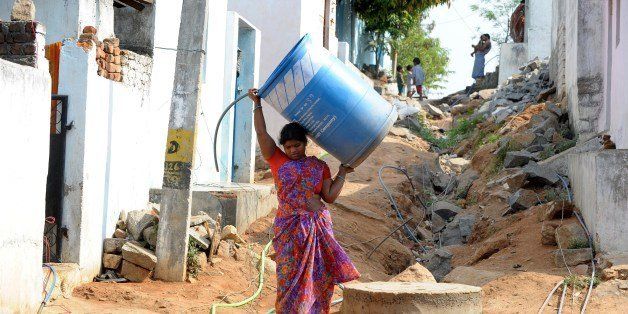
It all started with trying to answer the simple question: "When will I get my water next?" For many people, especially in parts of Europe and North America, the answer is as simple as, "When I turn on my tap." But for three billion others around the world, the answer is much more complicated.
The reason is a little thing called intermittent supply. Millions of households in emerging markets have piped water supply; however, in some cases, water is only available for a few hours at a time. For example, in Hubli-Dharwad, a city of 1.1 million people in the state of Karnataka, India, the local utility provides piped water once every two to four days. Depending on the season and the neighborhood, it can be up to 10 days between deliveries. Large storage containers can be prohibitively expensive and impractical in crowded urban settlements, and multiple storage containers are required to collect enough water to last for five days. Water-intensive chores, such as the washing of clothes and dishes, are often saved for the day of water delivery.
So why don't those three billion people have water all the time? Most people are under the assumption that it is due to a water shortage problem. In some situations, it is. But more often than not, the problem is actually energy scarcity. In order for you to have water come through your taps all the time, it needs to be pumped from somewhere. And that pumping requires energy. Not only that, to have water flowing in the pipe network all the time, it needs to be kept sufficiently pressurized. Again, this requires energy. To give you a sense of the amount of energy needed to transport and deliver water, at one point, three percent of California's energy consumption was used to supply water to Southern California. Today, developed countries like the U.S. can handle that, but as many countries around the world, particularly underdeveloped and developing nations, struggle to meet energy demand just for every day power needs, you can see how the water problem is intrinsically tied to the energy problem. Or the water-energy nexus.
So where does a startup like NextDrop fit in to all of this? Three years since its start, with a team of 25 (and counting), the social enterprise has grown from answering citizens' questions about when they will receive water to simplifying water supply and delivery in urban environments across India. We tackle the problem of managing existing resources -- a pain point very few people are actually aware of. And one that NextDrop has been actively working with utilities to address by providing them with data on where their water goes to help them make informed decisions about distribution.
How do we do it? We use human sensors -- simply put, people with their mobile phones. For the first time, NextDrop allows citizens to provide feedback to their utility on what is going on with their water supply, and works with the utility to make sure we give the right updates to the right person, at the right time. It's a live, human-powered smart grid solution to tackle water issues around the globe.
How does it work? As an example, let's say NextDrop sends you a text message informing you that the utility intends to provide you with water in two hours -- but two hours later, no water. You inform NextDrop via text message. Then NextDrop reports this information to the utility's engineer, who looks into the issue to figure out why. Chances are, there could be a damaged pipe in your area -- which now, the engineer can diagnose instantaneously. Otherwise, days, sometimes weeks could pass, with a) people not receiving water b) engineers not knowing that water is not being delivered to people he thought it was getting to c) precious water getting wasted. In our small way, we're trying to work with governments and citizens to make water delivery more efficient, and equitable by providing greater transparency and real-time data.
And that's just the start. After being one of seven finalists in the 2013 Unilever Young Entrepreneurs Awards competition, NextDrop has been inspired to provide more products for consumers -- especially around water quality. Many large corporations have made public commitments to enabling clean water supply to millions of people over the next few decades, and we want to do our part too. We've recently started to use NextDrop's real-time data and messaging system to inform subscribers when there is a damaged pipe in their area -- which means that not only will their water supply be disrupted, but there is a high likelihood that contaminants are present in the drinking water they do receive. This is an exciting new service that we're just starting to pilot, and that we're hoping to roll out full scale soon as well.
At NextDrop, all we were trying to do was let people know when their water would come on. What sounded so simple, turned out to be deceptively complex. Sometimes the greatest innovations happen while trying to solve the simplest problems. And sometimes, the most basic solutions are really the most effective. Citizens. Mobile phones. NextDrop.